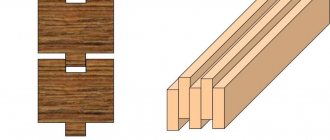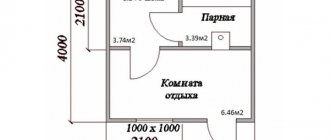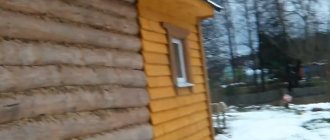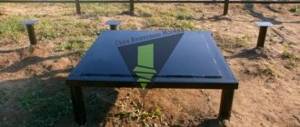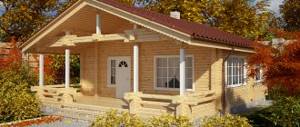Abash is a tree that Russia imports, so it is not cheap. We don’t know how much it costs in Africa itself, but here they sell it at a high price and tell tales to assure the buyer that he has made the best choice in his life.
We looked for purely technical information on Abash and compared it with similar characteristics of breeds more familiar to Russia. You can draw your own conclusions.
African tree: myths about abasha
But it’s worth starting with the heresy that we happened to read on the topic before we decided to write this article. Some statements are simply shocking... with the ignorance of the writers.
So, what do those who strive to advertise the product at any cost say?
The main emphasis, of course, is on the fact that you won’t get burned if you sit on the shelves in a steam room heated to sauna temperatures without a towel or sheet.
And then they begin to tell you how hard and dense the tree is, how easy it is to process and how resistant it is to various mechanical influences.
Someone will add that this African bathhouse tree does not rot at all and is extremely resistant to fungi .
It is also called oak - purely for marketing reasons, I suppose. Because those who call it "maple" at least do so because of the similarity of the leaves in shape to maples. And abashi has nothing in common with oak at all.
So, let's summarize. The main trick of the “sellers” is that something good in one thing must be made good in everything, and real dignity must be brought to a superpower. Elementary illiteracy can be added to this.
Abash for a bathhouse can be really good, although it is also important here - for what kind of bathhouse: Russian or Finnish? Because you won’t be able to get burned in Russian.
Otherwise, wood is like wood - it burns and rots, it is stable according to its hardness class and nothing more.
Technical and operational capabilities of abasha wood
Abashi wood has unique technical characteristics:
- density up to 420 kg/m3;
- withstands compression loads up to 280 kg/cm2;
- on bends withstands loads up to 528 kg/cm2.
After heat treatment at a temperature of 230 °C, the wood changes color and does not rot.
Drying
“African maple” is very critical to drying conditions, but it dries quickly. If drying is carried out without good air circulation, pathogenic microflora affects the workpiece. Before drying, the wood is kept for at least two days.
The sawn tree has a specific smell, but during the drying process it disappears.
Dried wood acquires new qualities:
- Resistant to direct contact with steam and water.
- Light weight. For comparison: a dry cubic meter of abashi weighs no more than 420 kg, while oak wood weighs 700 kg.
Grade
Abashi wood is of high grade. Products made from it have no knots or defects. They have a uniform texture and color, so they look very attractive.
All products made from abashi are classified as extra class. Larch, cedar and alder are completely combined with African maple wood during finishing work.
What's in reality?
In reality, this is a fairly common tree species in West Africa, which precisely because of its prevalence cannot be too expensive. But, as they say, “a heifer is half a heifer overseas, but a ruble is transported.”
Without going into botanical subtleties, I would like to clarify that abash is closer in relation to ordinary mallow, and not at all to oak or maple. It’s just that in Africa, mallows managed to grow into large trees.
Now let's start dealing with errors. Why is it believed that abashi is a tree for bathing? Because it has low thermal conductivity and heat capacity . In the case of wood, these characteristics will depend on the density of the species, and the density depends in part on the porosity and bound water within the fibers.
IMPORTANT! The lighter the wood, the lower its density, the less it heats up.
But the lower the density, the lower the hardness! But for some reason this point does not seem obvious to many. Hardness is the resistance of a material to the penetration of another body. In what case will it be higher: when the structure is loose or when it is dense?
Here is larch - dense, heavy wood. Very difficult to process. But linden is soft, light, and can be processed even with an ordinary knife. Abashi in this case is much closer to linden. Which, by the way, is confirmed by the words of the sellers themselves, who say that abash is easy to process.
In wood, density and hardness are partly related to how well the wood will resist rotting. Because it’s easier for mushrooms to eat soft and light ones (we’ll add – those that don’t contain resin).
But by the way! Abash has average resistance to rotting caused by fungi. This is better than linden and aspen.
Further. Let's compare the characteristics of such popular bathhouse species as linden, aspen and abash!
Technical characteristics and properties
| PROPERTIES | LINDEN | ASPEN | ABASH |
| Average density | 490–530 kg/m³ | 450 kg/m³ | 350 kg/m³ |
| Density limits | 320–600 kg/m³ | 360–600 kg/m³ | 320-700 kg/m³ |
| Longitudinal shrinkage | 0,3 % | 0,4 % | no data |
| Radial shrinkage | 5,5 % | 3,3 % | 3,3% |
| Tangential shrinkage | 9,1 % | 8,2 % | 5,6% |
| Radial swelling | 0,15–0,23 % | 0,13 % | no data |
| Tangential swelling | 0,24–0,32 % | 0,25–0,31 % | no data |
| Flexural strength | 90-106 N/mm² | 76 N/mm² | 52 N/mm² |
| Compressive strength | 44-52 N/mm² | 36 N/mm² | 30 N/mm² |
| Tensile strength | 85 N/mm² | 69 N/mm² | no data |
Please note that the indicators of abasha are closest to aspen .
And it cannot be said that aspen is much inferior to it (in some ways it is even superior to abash). Separately, we present another plate that shows resistance to biological damage.
Pay attention to the paragraph that talks about fear of dampness - this is a reason to think about whether you have good ventilation .
In addition, it is worth mentioning that despite good nailability , the abash does not hold fastenings well . However, it sticks together perfectly .
And a little more about wood. The core and sapwood of abasha are practically indistinguishable from each other in color. But sapwood has a property - it is easier to rot and become infected . Consequently, some of the material will obviously be more vulnerable; maybe it’s worth thinking about impregnating it with at least oil or wax? Antiseptics are also used to prevent rotting. In addition, manufacturers offer wood that has undergone industrial impregnation - impregnated.
conclusions
Well, firstly, its thermal conductivity low, judging by the fact that its cube is one hundredweight lighter than an aspen cube.
Oddly enough, but abash, in our opinion, is very close to the properties of poplar (aspen is a type of poplar). Although some characteristics are, of course, better.
The good news is that it warps and cracks little or moderately. And in general, his performance is quite average. It takes only low thermal conductivity.
IMPORTANT! In this situation, only sauna owners need it. And even then, a towel may well make you insensitive to its absence.
In general, good top-class aspen is a worthy competitor to abashu in a steam room.
Operation of interior items made of triplochiton
The main problem in operating a steam room finished with abasha clapboard is the appearance of stains on light wood. They occur after the evaporation of not very pure water from the surface. You should not try to prevent this phenomenon with the help of impregnations and oils - this will increase the thermal conductivity of the array.
Stains should be removed as they appear. This is done with water and a regular brush. Also, you should not leave the bathhouse closed after use; you must ventilate the premises. Remaining moisture can cause mold and mildew to form on the wood.
Despite some difficulties during installation and operation of the bathhouse, abashi wood will delight you with its unique properties and excellent appearance. And if you follow the rules for finishing work and carefully care for the wood, interior items and wall cladding made of African oak will ensure a long service life.
What can be found on sale
Depending on what your task is, you can either buy a lining for a bathhouse made of abasha, or a plank for a shelf. There are no timber and logs, windows and doors, furniture for sale.
Lining
In online stores you can find a variety of offers with a wide range of prices, but we were primarily interested in dimensions and grade.
“Extra” class lining available , but also “A” and even “AB” lining - this, by the way, refutes another myth - that the tree is so wonderful that only “Extra” can be made from it. In fact, there are always defects, which is reflected by different grades.
Dimensions, as usual, vary among different manufacturers, but in general it is thickness from 12 to 13 mm, width 85, 90, 92, 96 mm (they do not write whether this size is indicated with or without a spike), length varies from 2 to 4 meters, but more often no more than 3 meters.
Abasha lining, photo “Stoves at Demyan’s”
shelves
Hmmm, we just now learned that the board, usually called “planken”, which is used to cover the frame of shelves, is often simply called “shelves” on sale .
So you can safely contact the sellers with a question about how much they buy abashi shelves for a bathhouse, and in response you will hear the price per linear meter of boards.
The usual dimensions of the board are as follows: width 95 mm, thickness 25 mm. Length up to 4 meters.
Conclusion
African oak - abash has become one of the most popular materials for baths. This is due to the fact that in terms of performance qualities for a steam room, it has no equal. Moreover, the use of this wood can be found not only in saunas and baths, but also in the interior of a residential building.
For more information on this topic, watch the video in this article.
Not every owner of a home bath can afford to use an abash for a bath. There are many restrictions on the use of various exotics in the steam room and washroom, but the mass use of new material is limited primarily by price. Apparently, there is something especially valuable and attractive in the texture of abasha wood, if over the past five years the demand for cladding has caught up with traditional linden and cedar.
Beware: fake!
Few people have not heard about the African miracle tree and its high cost, so it is not surprising that proposals for an Asian counterpart began to appear on the market, which is in no way inferior in quality, but will be cheaper.
But the abash tree has no brothers at all - it is one of a kind. Moreover, the latter should be taken literally - triplochiton durumis is the only representative of the genus Triplochiton.
Therefore, if we are talking about “Asian abasha”, then it must be some kind of analogue. Various sources say that this is either a silk tree, that is, a type of acacia (Albizia Lankaran), or Alstonia.
However, neither we are specialists in botany, nor are most of our readers. We have already found out above that, apart from low thermal conductivity, abashi has no particularly outstanding advantages. This means that a fake will be inferior to the original only if it has a higher density. Or if it is not suitable for a bath with high humidity .
Fortunately, checking the first is quite simple - find out the weight of a cubic meter of the Asian analogue and compare it with 350 kilograms of a cube of original wood dried to 12% moisture content.
But it’s good if you were at least warned that this is an analogue. But they can pass it off as an African abash. To prevent this from happening, focus on the color - the original have yellowness , it can be almost white, but with a tint, like butter. Or yellower, the color of straw. But the analog has gray shades together with yellow.
If you were offered cheap wood and you doubted it, think about this: maybe it’s better to take a well-known, easier to identify linden or aspen than an unknown exotic one?
Useful video
The author of this video has an amazing ability to talk about platitudes for a long time, but he is the only one who decided to make a video on different types of wood:
By the way, he says that abash brought from China smells bad. In reality, it all smells bad when freshly cut . After drying, the smell disappears. If your abash gives off an unpleasant odor, then it is most likely under-dried.
***
We are wondering if you want to decorate your steam room with abash? Write a comment and, if possible, state the main reason for your choice.




